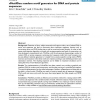84 search results - page 7 / 17 » The Context-Dependence of Amino Acid Properties |
BIBE
2003
IEEE
14 years 23 days ago
2003
IEEE
Contact map prediction is of great interest for its application in fold recognition and protein 3D structure determination. In this paper we present a contact-map prediction algor...
BIBM
2009
IEEE
14 years 2 months ago
2009
IEEE
—We present a new algorithm, ChemAlign, that uses physicochemical properties and secondary structure elements to create biologically relevant multiple sequence alignments (MSAs)....
ICANN
2003
Springer
14 years 20 days ago
2003
Springer
We search for assignments of numbers to the amino acids (property codes) that maximize the autocorrelation function signal in given protein sequence data by an iterative method. Ou...
BMCBI
2005
13 years 7 months ago
2005
Background: The chemical property and biological function of a protein is a direct consequence of its primary structure. Several algorithms have been developed which determine ali...
BMCBI
2007
13 years 7 months ago
2007
Background: Detection of short, subtle conserved motif regions within a set of related DNA or amino acid sequences can lead to discoveries about important regulatory domains such ...

